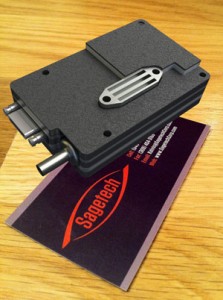Kansas State University at Salina’s unmanned aircraft programme is the first to use the XPS-TR transponder developed by Sagetech Corporation, which has shattered size records with a footprint smaller than that of a standard business card.
The Sagetech transponder is special because it can fit easily on small unmanned aircraft and it was recently installed in K-State’s Aerosonde Mark 4.7.
K-State uses the Aerosonde Mark 4.7, produced by AAI Corporation, as a general-purpose research platform. Weighing about 50 pounds and not much larger than a Canada goose, the unmanned vehicle is naturally invisible to air traffic control primary radar. Though stealthy radar invisibility can be a benefit during covert military operations, the inability of air traffic control to monitor unmanned aircraft locations presents a significant barrier for civilian missions in the national air space.
“Adding a transponder to the unmanned platform is a step toward eliminating that barrier,” said Kurt Barnhart, head of the department of aviation and director of the Applied Aviation Research Center at K-State Salina.
Sagetech’s XPS-TR transponder includes automatic dependent surveillance-broadcast in and out capability, which allows the unmanned aircraft vehicle operator to electronically see surrounding aircraft, greatly improving situational awareness. This means the transponder also can transmit the aircraft’s altitude, identification, selected heading and much more. Barnhart said this is ideal where size, weight and power are at a premium, such as with small unmanned aircraft. The transponder’s small size and weight create more fuel and payload carrying capacity, providing greater flight endurance and mission capability.
“Sagetech’s products are plug-and-play compatible with the Cloud Cap autopilot system that we use to control our Aerosonde. We’re especially excited about the automatic dependent surveillance-broadcast in and out capability that will offer a paradigm shift in our ability to integrate into the national airspace system,” said Josh Brungardt, director of K-State’s unmanned aircraft systems program office.
Sagetech Corporation president and founder Kelvin Scribner said he was excited to work with K-State and the AAI Corporation as the first customer for this product line. “Having worked with Aerosonde in 1996, it’s especially meaningful to come full circle and be part of the Aerosonde Mark 4.7 team, now as part of Sagetech Corporation,” Scribner said.
“K-State continues to impress with their forward thinking as early adopters of some of the most exciting capability offered small unmanned aircraft since the microcontroller-based autopilot,” said Canyon Peckham, director of engineering at Sagetech.
Sagetech Corporation has been successfully taking engineering concepts from design to production for the unmanned aviation industry since 1998. An unmanned aviation vehicle sub-systems designer and manufacturer specializing in electronics, Sagetech is the original designer of the Insitu ScanEagle UAS Avionics and Mode C Transponder. They have produced more than 20,000 sub-system deliveries since 2000, at a defect-free rate of more than 99.7 percent and an on-time delivery rate of more than 99.8 percent.
K-State’s unmanned aircraft systems programme office includes the Unmanned Aircraft Systems Technology Evaluation Center and a full surface mount technology lab for unmanned aircraft avionics and payload miniaturization. It also collaborates with military organizations and the private sector to develop unmanned flight in the nation’s airspace and training pilots and operators of unmanned aerial systems.
K-State establishes criteria for unmanned aircraft system flight operations, including activity at the Smoky Hill Weapons Range, and eventually at the Herington unmanned aircraft system flight facility. The unmanned aircraft systems program office establishes policies and procedures to enable both military and civilian organizations to fly and test at the area facilities.
For further information contact Natalie Blair at Kansas State University nblair@k-state.edu

